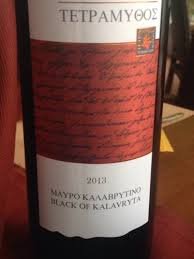Travels in Greece - Achaia
Greece - a country of oceans and mountains. A country of ancient mysteries. A country of incredible beauty. A country beset by economic turmoil. Into this crazy world I went wandering through the mountainous region of the north-west Peloponnese – Achaia (Ah-hi-ya).
The area has much to offer the traveller – from ancient subterranean lakes at Spilaio Limnon with its otherworldly geological formations, to the Archeological Museum of Patras, to beautiful beaches, and to wineries, the reason for my trip.
I was curious not only to explore this wine region - one of Greece's largest with approximately 10% of the country's wine production - but also to take the pulse of the Greek wine industry, especially given the current economic crisis. One potentially troubling fact is that approximately 70% of wine production is consumed locally. If internal consumption contracts, for example, how will wineries respond? Will they produce less wine? Will they purchase fewer grapes from local growers who rely on sales to these wineries for their subsistence? There will likely be a trickle-down effect.
However, according to Konstantinos Lazarakis, Greece’s first Master of Wine, the future of the market is extremely positive. While the majority of wine currently stays in the country, wineries are exploring the possibility of exporting as a way of diversifying. Achaian wineries Tetramythos and Cavino are already tapping this market with export sales of 75% and 80% respectively. Lazarakis states, “Things might get in the way but they will only be hiccups. I put my money (my euros that is) on Greek wine and not only because I am Greek.”
So what about the Achaian wines? There are 31 wineries in the region. I tasted wines from wineries from the oldest and historic Achaia Clauss, founded in 1854, to Tetramythos, a relative newcomer to the Greek wine scene.
Mavrodaphne and Roditis are the main grapes of the region. Mavrodaphne, best known for its sweet wines, is also made in a dry style. Roditis, a pink-skinned grape, produces a dry white wine. But Greece is home to over 300 indigenous varietals, most of which we, in North America, have never heard of. And many wineries are bringing back some of these lesser known grapes.
My favourite of these “new” grapes is Mavro of Kalavryta, of which just four hectares are planted in Greece, and all are found in Achaia. Tetramythos, which owns almost half of all plantings, produce what was one of the standout wines of the trip. Their 2014 vintage was Gamay-like with loads of bright red cherry and strawberry, very fine but present tannins and a delicious cranberry finish. This wine really spoke to me and I look forward to revisiting it!
My white wine pick was Oenoforos Asprolithi or “White Stone” Roditis 2014. It is loaded with green apple and yellow peach with zesty lemony notes on the palate. With its lighter body and long finish, it’s a refreshing and easy-drinking wine.
Greek wines are making their way into the North American market, and the annual Greek wine tasting, held in various cities across Canada and the US, is becoming more and more popular. Despite Greece’s economic woes, I am excited to see how its wine industry evolves.





